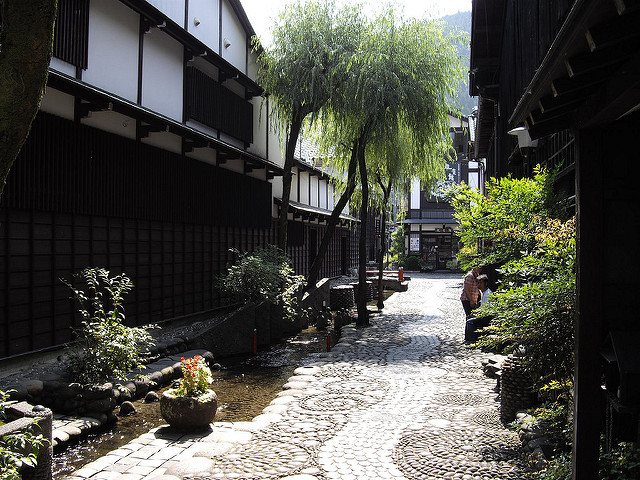Nov 01, 2017
Gujo Hachiman, an Edo Era Town That’s Much More Than a Song and a Dance
You may recall that, back in July, we posted about the Gujo Hachiman Bon Odori festival, a four day extravaganza of all night dancing, perhaps the most famous event of its type in all of Japan.
While it is quite an extraordinary sight, there is a good chance that you were unable (or even disinclined) to spend all night strutting your traditional Japanese stuff. However, that is no reason to neglect the town in its entirety.
Located in the centre of Gifu Prefecture, Gujo Hachiman is beautiful old town surrounded by rivers and waterways, and was founded following the construction of Gujo Hachiman Castle in 1559. To this day, the town retains its delightful old world charm and is a fantastic destination for a day trip, with plenty of things to see and do.
Gujo Old Town

The old town is captivating, and as some historic parts still date from its castle town days – such as the artisans’ district, the blacksmiths’ district, and the Yanagimachi district – just strolling through feels like you are stepping back in time to the age of samurai.
The town is surrounded by pristine waterways and canals with fish swimming along streams by the Igawa-komichi alley and the street-corner Yanaka Mizu-no-komichi alley, sourced at the Yoshida River that flows through the town. And while these old waterways are picturesque, they are also practical. In 1652 a fire raged through the town, burning half of it to the ground. Not wishing to see a repeat, sixth-generation castle lord Tsunetomo Endo decided to construct these waterways to keep the town safe, and they remain to this day.
All around the town you can find museums that exhibit various aspects of the city’s culture. The Gujo Hachiman Hakurankan City Museum holds demonstrations of Gujo’s festival dances several times a day, the Saito Museum has a collection of tea ceremony artifacts and the Anyoji Temple Treasure House displays objects, such as Buddhist paintings and scriptures, that are important to the temple.
Gujo Hachiman Castle
In the old town is the Castle, around which the town was constructed, and while it is not the original structure, which was torn down in 1870 following the Meiji Restoration, the wooden reconstruction was built in 1933 and stands today continuing, to add to the town’s old world charm.
As was standard in the Edo period, the castle was built on top of a hill as this served as protection from attacking hordes. Today those hordes are instead tourists, and thousands are drawn to the castle to take advantage of its stunning views of the town in the valley below.
Food Replicas
Have you ever seen those wax and plastic replications of food (shokuhin sampuru, literally food sample) outside of Japanese restaurants and wondered how they were made and where they come from? Well wonder no more. A good 70 per cent of these ‘samples’ are made in Gujo Hachiman, and no trip to the town is complete with out a visit to a sample center.
The first replica workshop, Iwasaki Mokei, opened in 1932 and today, like the other workshops in Gujo, continues to produce a wide variety of replicas from sushi and ramen to hamburgers and ice cream. Here, and at Sample Kobo, as well as watching the artisans at work, visitors can try to create their own samples, such as leaves of lettuce or pieces of tempura, under the direction of a replica artist.
Jionzenji Temple
Jionzenji Temple was founded in the 16th century by the feudal lord Endo Yoshitaka, and though the temple buildings were destroyed by flooding in 1893, they were restored three years later. Unfortunately they were again destroyed by a landslide in the 1950s, and once more rebuilt.
Jionzenji is best known for is its Tetsuso-en Garden, an enchanting space first laid out by the original head priest Hanzan some 400 years ago. The garden has many of the classic features of Japanese gardens, including a small waterfall, stepping stones, stone lanterns and a ‘suikin kutsu‘, all of which create a sensation of utter zen-like relaxation and meditation. The gardens may not be accessed by tourists, however they can be viewed from the temple grounds.
Getting to Gujo
- Train: Gujo Hachiman Station is connected to the Nagaragawa Railway by Mino-Ota and can be accessed from Nagoya JR Station via Gifu or Ogaki. It takes around 145 minutes and costs approximately 2,500 JPY.
- Bus: Gifu Bus operates one round trip bus per day between Meitetsu Bus Center and Shirakawago that stops in central Gujo along the way. The one way trip takes 80 minutes and costs 2060 JPY.
Nohi Bus, Meitetsu and JR Tokai Bus operate nine round trips per day between the Nagoya Meitetsu Bus Center and Takayama, which stop along the way at “Gujo-Hachiman Inter”, a stop located along the expressway outside of the town center. The one way trip between Nagoya and Gujo takes 90 minutes and costs 1850 JPY. A round trip ticket is available for 3190 JPY and is valid for four days. - Google map to Gujo Hachiman Station
By Mark Guthrie
Image by tetsu-k. (Own work) [CC BY-SA 2.0], via flickr.com (modified)
Image by つだ (Own work) [CC BY-SA 2.0], via flickr.com (modified)
Image by Tetsushi Kimura (Own work) [CC BY-SA 2.0], via flickr.com (modified)
Image via http://samplekobo.com/products/ (modified)
Image by paulcantrell (Own work) [CC BY-SA 2.0], via flickr.com (modified)






About the author